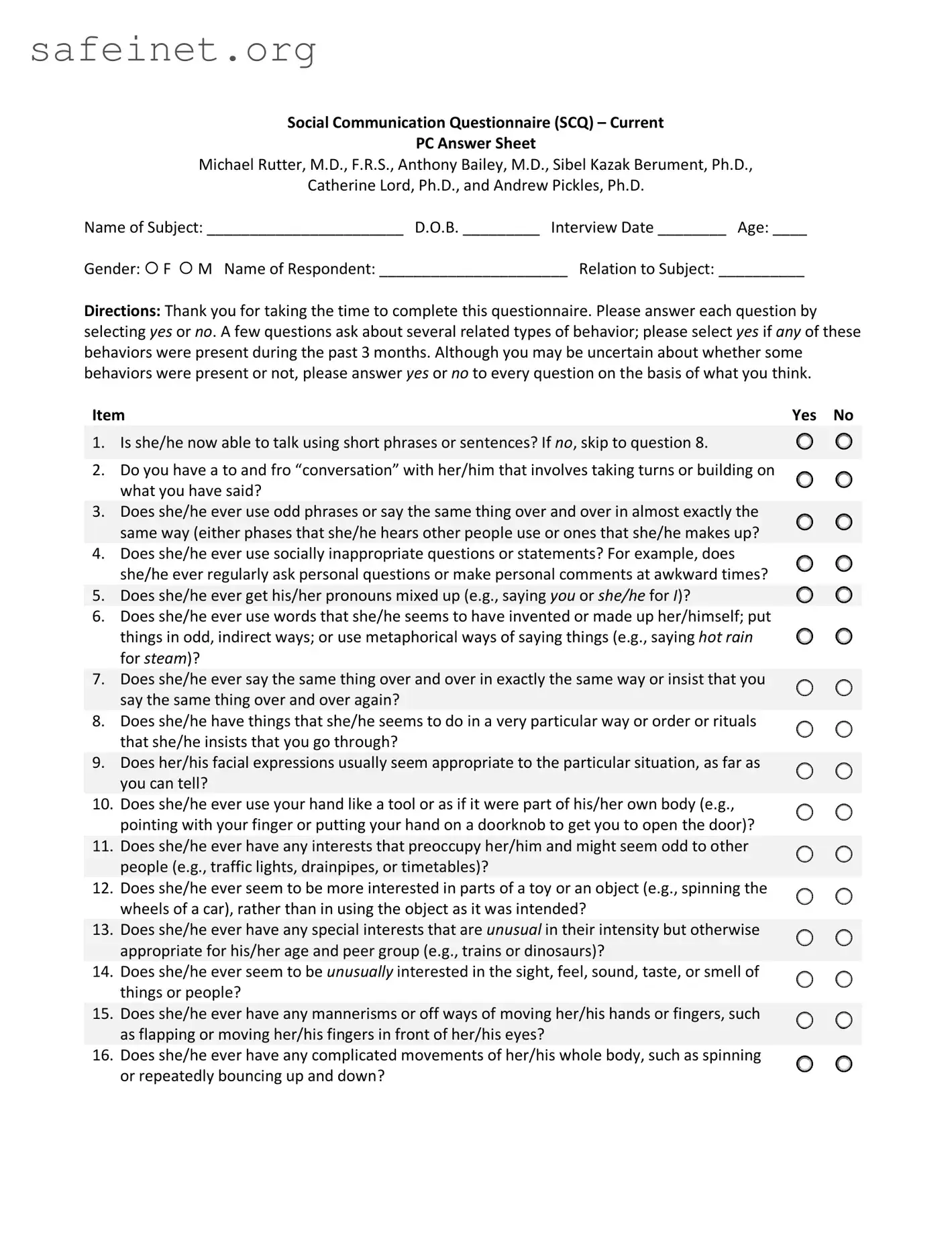SOCIAL COMMUNICATION QUESTIONNAIRE (SCQ) – CURRENT
PC ANSWER SHEET
Michael Rutter, M.D., F.R.S., Anthony Bailey, M.D., Sibel Kazak Berument, Ph.D.,
Catherine Lord, Ph.D., and Andrew Pickles, Ph.D.
Name of Subject: _______________________ D.O.B. _________ Interview Date ________ Age: ____
Gender: F M Name of Respondent: ______________________ Relation to Subject: __________
DIRECTIONS: Thank you for taking the time to complete this questionnaire. Please answer each question by selecting yes or no. A few questions ask about several related types of behavior; please select yes if any of these behaviors were present during the past 3 months. Although you may be uncertain about whether some behaviors were present or not, please answer yes or no to every question on the basis of what you think.
ITEM |
|
YES |
NO |
|
|
|
|
|
|
|
|
|
|
|
1. |
Is she/he now able to talk using short phrases or sentences? If no, skip to question 8. |
|
|
|
|
|
|
|
|
|
|
|
|
|
|
|
|
|
|
|
|
|
|
|
|
|
|
|
2. |
Do you have a to and fro “conversation” with her/him that involves taking turns or building on |
|
|
|
|
|
what you have said? |
|
|
|
|
|
|
|
3. |
Does she/he ever use odd phrases or say the same thing over and over in almost exactly the |
|
|
|
|
|
|
|
|
|
|
|
|
|
|
same way (either phases that she/he hears other people use or ones that she/he makes up? |
|
|
|
|
|
|
|
|
|
|
|
4. |
Does she/he ever use socially inappropriate questions or statements? For example, does |
|
|
|
|
|
she/he ever regularly ask personal questions or make personal comments at awkward times? |
|
|
|
|
|
|
|
|
5. |
Does she/he ever get his/her pronouns mixed up (e.g., saying you or she/he for I)? |
|
|
|
|
|
6. |
Does she/he ever use words that she/he seems to have invented or made up her/himself; put |
|
|
|
|
|
|
|
|
things in odd, indirect ways; or use metaphorical ways of saying things (e.g., saying hot rain |
|
|
|
|
|
for steam)? |
|
|
|
|
|
|
|
7. |
Does she/he ever say the same thing over and over in exactly the same way or insist that you |
|
|
|
|
|
|
|
|
|
|
|
|
|
|
say the same thing over and over again? |
|
|
|
|
|
|
|
|
|
|
|
8. |
Does she/he have things that she/he seems to do in a very particular way or order or rituals |
|
|
|
|
|
that she/he insists that you go through? |
|
|
|
|
|
|
|
|
|
|
9. |
Does her/his facial expressions usually seem appropriate to the particular situation, as far as |
|
|
|
|
|
|
|
|
|
|
|
|
|
|
|
you can tell? |
|
|
|
|
|
|
|
|
|
|
|
|
10. |
Does she/he ever use your hand like a tool or as if it were part of his/her own body (e.g., |
|
|
|
|
|
pointing with your finger or putting your hand on a doorknob to get you to open the door)? |
|
|
|
|
|
|
|
|
|
|
|
|
|
|
|
|
|
|
11. |
Does she/he ever have any interests that preoccupy her/him and might seem odd to other |
|
|
|
|
|
|
|
|
|
|
|
|
|
|
people (e.g., traffic lights, drainpipes, or timetables)? |
|
|
|
|
|
|
|
|
|
|
|
12. |
Does she/he ever seem to be more interested in parts of a toy or an object (e.g., spinning the |
|
|
|
|
|
wheels of a car), rather than in using the object as it was intended? |
|
|
|
|
|
|
|
13. |
Does she/he ever have any special interests that are unusual in their intensity but otherwise |
|
|
|
|
|
|
|
|
|
|
|
|
|
|
|
appropriate for his/her age and peer group (e.g., trains or dinosaurs)? |
|
|
|
|
|
|
|
|
|
|
|
|
|
|
|
|
|
|
|
|
|
|
14. |
Does she/he ever seem to be unusually interested in the sight, feel, sound, taste, or smell of |
|
|
|
|
|
things or people? |
|
|
|
|
|
|
|
|
|
|
|
|
|
|
|
|
|
|
15. |
Does she/he ever have any mannerisms or off ways of moving her/his hands or fingers, such |
|
|
|
|
|
|
|
|
|
|
|
|
|
|
|
|
|
|
|
as flapping or moving her/his fingers in front of her/his eyes? |
|
|
|
|
|
|
|
|
|
|
|
16. |
Does she/he ever have any complicated movements of her/his whole body, such as spinning |
|
|
|
|
|
or repeatedly bouncing up and down? |
|
|
|
|
|
|
|
|
|


